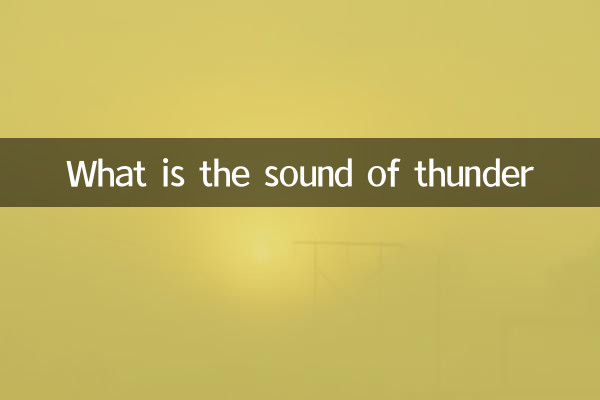What is the sound of thunder
Thunder is a natural phenomenon, usually accompanied by lightning and heavy rain. Its sound is a shock wave formed by the rapid expansion and compression of high-temperature air produced by lightning. Thundering has occurred frequently in social media and scientific discussions in recent years, especially in its association with climate change and extreme weather events. This article will analyze the principle of thunder sound, recent hot topics and related data.
1. The principle of thundering sound

The sound of thunder comes from the huge release of energy produced by lightning. As lightning passes through the air, the surrounding air is rapidly heated to tens of thousands of degrees Celsius, causing the air to expand sharply and form a shock wave. This shock wave travels in the form of sound waves, forming the thunder we hear. The magnitude and duration of thunder depends on the length of lightning, the speed of energy release, and the distance of the observer.
| factor | Effect on thunder |
|---|---|
| Lightning length | The longer the lightning, the longer the thunder lasts |
| Energy release speed | The faster the energy is released, the louder the thunder is |
| Observer distance | The farther the distance, the lower the thunder |
2. Recent hot topics
In the past 10 days, hot topics related to thunder have focused on the following aspects:
1.Extreme weather events: Rare thunderstorms have occurred in many places around the world, causing public concerns about climate change.
2.Lightning accident: Some areas reported casualties and property losses caused by lightning strikes.
3.Scientific explanation: Popular science bloggers and meteorological experts share the scientific principles of thunder on social media, attracting a lot of attention.
| topic | Popularity index | Main discussion platform |
|---|---|---|
| Extreme weather events | 85 | Twitter, Weibo |
| Lightning accident | 75 | News websites, Facebook |
| Scientific explanation | 90 | YouTube, Zhihu |
3. Types of thundering sounds
There are not a single sound of thunder, but there are many types, as follows:
| type | describe |
|---|---|
| Boom | Common thunder, low and long-lasting |
| Breaking sound | Short and loud, usually happening in close range lightning |
| Scroll sound | It is formed by multiple lightning reflections, and the sound gradually weakens |
4. How to deal with thunder safely
Thunder, while spectacular, can also pose danger. Here are a few safety measures:
1.Indoor lightning protection: Try to stay indoors when thunder, close doors and windows, and avoid using electrical appliances.
2.Stay away from high places: Avoid standing high or isolated under large trees when outdoors.
3.Avoid contact with metal: Metal objects are prone to conduct electricity, and contact should be avoided when thunder occurs.
5. Summary
The sound of thunder is a wonderful phenomenon in nature, but behind it is complex scientific principles. By analyzing recent hot topics, we can see that the public's attention to thunder phenomenon is increasing. Understanding the principles and safety knowledge of thunder can not only satisfy our curiosity, but also help us protect ourselves in extreme weather.
In the future, as climate change intensifies, extreme weather events such as thunder may be more frequent. Therefore, popularization of science and public education are particularly important. I hope that through the sharing of this article, we can help everyone better understand and deal with thunder phenomenon.

check the details

check the details